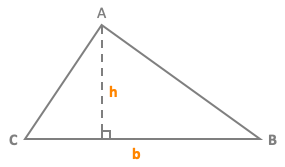Area of a triangle |

|
|
1
2
x b x h =
b x h
2
|
|
CB = base = b h = height ExampleABC is a triangle with a base b = 8 cm and a height h = 4 cmArea A of a triangle ABC =
b x h
2
=
8 x 4
2
= 16 cm²
Calculate the area of a triangle |
TriangleA triangle is a polygon with three sides and three angles. The sum of its interior angles is always 180 degrees. Triangles are classified by side lengths (equilateral, isosceles, or scalene) and by angles (acute, obtuse, or right-angled).The area (A) of a triangle can be calculated using the formula: A= 1/2 × base × height where the base is the length of one side of the triangle, and the height is the perpendicular distance from the base to the opposite vertex. Properties of a triangleYou will find below triangle properties:Three sides: a triangle has three sides, and the sum of the lengths of any two sides must be greater than the length of the third side. Three angles: the sum of the interior angles of a triangle is always 180 degrees. Classification by sides: Equilateral: all sides are of equal length. Isosceles: two sides are of equal length. Scalene: all three sides have different lengths. Classification by angles: Acute: all angles are less than 90 degrees. Obtuse: one angle is greater than 90 degrees. Right-angled: one angle is exactly 90 degrees. ExamplesHere are five examples of calculating the area of a triangle using the basic formula A = 1/2 × base × height. These examples demonstrate the application of the formula for calculating the area of a triangle using given base and height measurements.Example 1:Base = 10 units, Height = 5 unitsA = 1/2 × 10 × 5 = 25 square units Example 2:Base = 12 units, Height = 8 unitsA = 1/2 × 12 × 8 = 48 square units Example 3:Base = 6 units, Height = 7 unitsA = 1/2 × 6 × 7 = 21 square units Example 4:Base = 15 units, Height = 4 unitsA = 1/2 × 15 × 4 = 30 square units Example 5:Base = 9 units, Height = 10 unitsA = 1/2 × 9 × 10 = 45 square units |